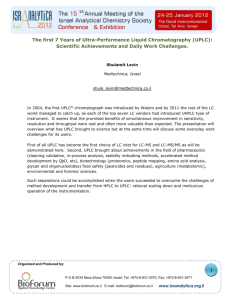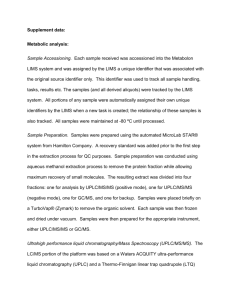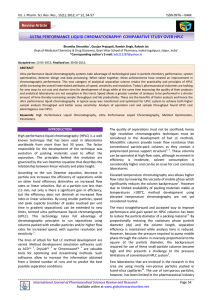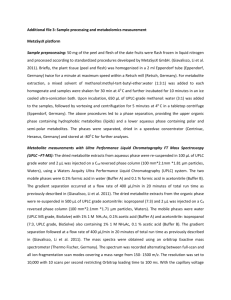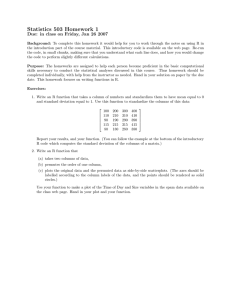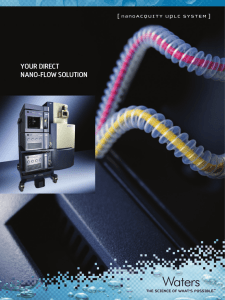Document 13309174
advertisement
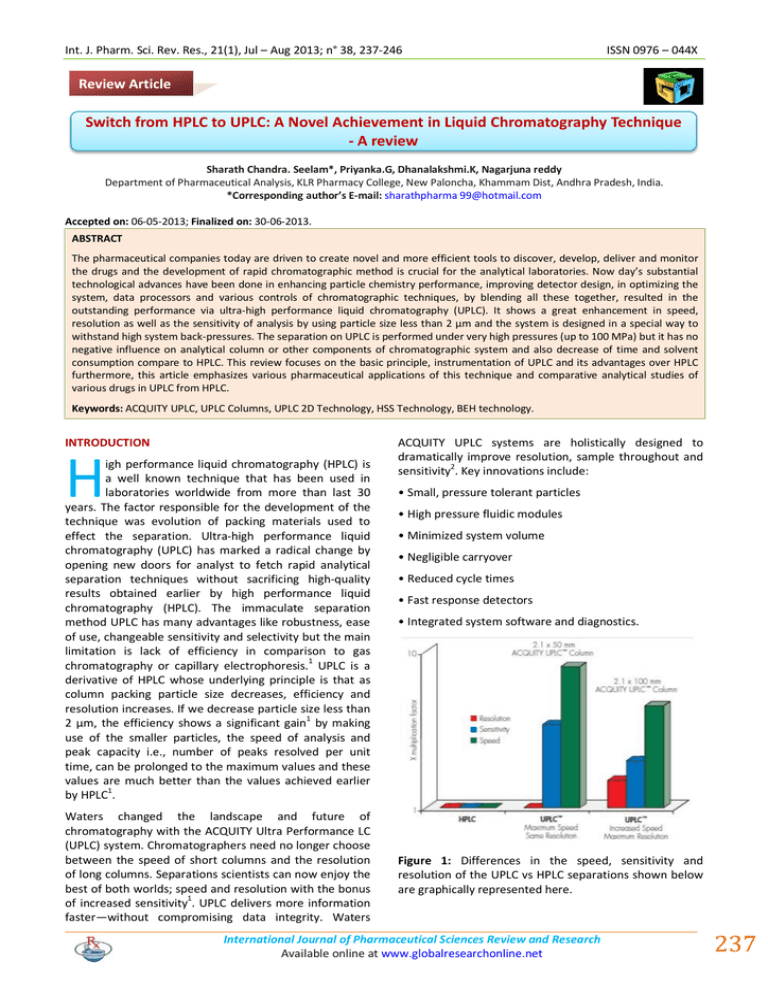
Int. J. Pharm. Sci. Rev. Res., 21(1), Jul – Aug 2013; n° 38, 237-246 ISSN 0976 – 044X Review Article Switch from HPLC to UPLC: A Novel Achievement in Liquid Chromatography Technique - A review Sharath Chandra. Seelam*, Priyanka.G, Dhanalakshmi.K, Nagarjuna reddy Department of Pharmaceutical Analysis, KLR Pharmacy College, New Paloncha, Khammam Dist, Andhra Pradesh, India. *Corresponding author’s E-mail: sharathpharma 99@hotmail.com Accepted on: 06-05-2013; Finalized on: 30-06-2013. ABSTRACT The pharmaceutical companies today are driven to create novel and more efficient tools to discover, develop, deliver and monitor the drugs and the development of rapid chromatographic method is crucial for the analytical laboratories. Now day’s substantial technological advances have been done in enhancing particle chemistry performance, improving detector design, in optimizing the system, data processors and various controls of chromatographic techniques, by blending all these together, resulted in the outstanding performance via ultra-high performance liquid chromatography (UPLC). It shows a great enhancement in speed, resolution as well as the sensitivity of analysis by using particle size less than 2 µm and the system is designed in a special way to withstand high system back-pressures. The separation on UPLC is performed under very high pressures (up to 100 MPa) but it has no negative influence on analytical column or other components of chromatographic system and also decrease of time and solvent consumption compare to HPLC. This review focuses on the basic principle, instrumentation of UPLC and its advantages over HPLC furthermore, this article emphasizes various pharmaceutical applications of this technique and comparative analytical studies of various drugs in UPLC from HPLC. Keywords: ACQUITY UPLC, UPLC Columns, UPLC 2D Technology, HSS Technology, BEH technology. INTRODUCTION H igh performance liquid chromatography (HPLC) is a well known technique that has been used in laboratories worldwide from more than last 30 years. The factor responsible for the development of the technique was evolution of packing materials used to effect the separation. Ultra-high performance liquid chromatography (UPLC) has marked a radical change by opening new doors for analyst to fetch rapid analytical separation techniques without sacrificing high-quality results obtained earlier by high performance liquid chromatography (HPLC). The immaculate separation method UPLC has many advantages like robustness, ease of use, changeable sensitivity and selectivity but the main limitation is lack of efficiency in comparison to gas 1 chromatography or capillary electrophoresis. UPLC is a derivative of HPLC whose underlying principle is that as column packing particle size decreases, efficiency and resolution increases. If we decrease particle size less than 2 µm, the efficiency shows a significant gain1 by making use of the smaller particles, the speed of analysis and peak capacity i.e., number of peaks resolved per unit time, can be prolonged to the maximum values and these values are much better than the values achieved earlier 1 by HPLC . Waters changed the landscape and future of chromatography with the ACQUITY Ultra Performance LC (UPLC) system. Chromatographers need no longer choose between the speed of short columns and the resolution of long columns. Separations scientists can now enjoy the best of both worlds; speed and resolution with the bonus of increased sensitivity1. UPLC delivers more information faster—without compromising data integrity. Waters ACQUITY UPLC systems are holistically designed to dramatically improve resolution, sample throughout and sensitivity2. Key innovations include: • Small, pressure tolerant particles • High pressure fluidic modules • Minimized system volume • Negligible carryover • Reduced cycle times • Fast response detectors • Integrated system software and diagnostics. Figure 1: Differences in the speed, sensitivity and resolution of the UPLC vs HPLC separations shown below are graphically represented here. International Journal of Pharmaceutical Sciences Review and Research Available online at www.globalresearchonline.net 237 Int. J. Pharm. Sci. Rev. Res., 21(1), Jul – Aug 2013; n° 38, 237-246 ISSN 0976 – 044X performs more sensitive analysis, consumes less time, reduces solvent consumption and has high analysis speed1-3. PRINCIPLE Figure 2: Conditions HPLC Column: XTerra MS C18 2.1 x 150 mm, 5 µm; UPLC Columns: ACQUITY UPLC BEH C18 2.1 x 50 mm, 1.7 µm; ACQUITY UPLC BEH C18 2.1 x 100 mm, 1.7 µm; Mobile Phase A: 0.1% HCOOH; Mobile Phase B: ACN Isocratic Mobile Phase Composition: 75% A; 25% B; Flow Rates: HPLC: 0.20 mL/min; UPLC: 0.50 mL/min; Injection Volume: 5 µL; Sample Diluent: 0.1% HCOOH; Sample Concentration: 17 µg/mL; Temperature: 50 °C; Detection: UV @ 270 nm; Instrument: ACQUITY UPLC with ACQUITY UPLC 2996 PDA. Compounds: 1. Quercetin;2. Kaempferol; 3. Isorhamnetin. Principles are the same but not the performance: UPLC applies the same principle as HPLC, the difference is the use of sub 2-µm particle columns in a system holistically designed to maximise the advantages of these columns, creating a powerful, robust and reliable solution. The familiar design of UPLC H-class’s Quaternary Solvent Manager (QSM) and Sample Manager (SM-FTN), with flow-through needle design, gives all the flexibility and usability of your current HPLC while still achieving the highly efficient separations that only UPLC can provide3. To improve the UPLC efficiency following measures need to be performed: 1. Elevated temperature range should be employed, which will allow high flow rate of mobile phase by reducing its viscosity and thus it will significantly reduce back pressure. 2. Monolithic columns should be used, which consist of one piece of solid that possesses interconnected skeletons and interconnected flow paths (through-pores). UPLC is a technique which comprises the above mentioned features and stands better than HPLC in many ways as it shows better chromatographic resolution, The UPLC is based on the principal of use of stationary phase consisting of particles less than 2 µm while HPLC columns are typically filled with particles of 3 to 5 µm. The underlying principles of this evolution are governed by the van Deemter equation, which is an empirical formula that describes the relationship between linear velocity (flow rate) and plate height (HETP or column efficiency)4. It was found that HETP decreases to a minimum value and then increases with increasing flow rate. However, with the 1.7 µm particles used in UPLC, HETP is lowered compared to the larger particles and does not increase at higher flow rates. This allow faster separations to be carried out on shorter columns and/or with higher flow rates, leading to column increased resolution between specific peak pairs and increased peak capacity, defined as the number of peaks that can be separated with specified resolution in a given time interval. Efficiency is three times greater with 1.7 µm particles compared to 5 µm particles and two times greater compared to 3.5 µm particles. Resolution is 70% higher than with 5 µm particles and 40% higher than with 3.5 µm particles. High speed is obtained because column length with 1.7 µm particles can be reduced by a factor of 3 compared to 5 µm particles for the same efficiency, and flow rate can be three times higher. This means separations can be nine times faster with equal resolution. Sensitivity increases because less band spreading occurs during migration through a column with smaller particles (peak width is less and peak height greater). The Van Deemter curve, governed by an equation with three components shows that the usable flow range for a good efficiency with a small diameter particles is much greater than for larger diameters 4-5. H=A+B/v+Cv where A, B and C are constants v is the linear velocity, the carrier gas flow rate. The A term is independent of velocity and represents "eddy" mixing. It is smallest when the packed column particles are small and uniform. The B term represents axial diffusion or the natural diffusion tendency of molecules. This effect is diminished at high flow rates and so this term is divided by v. The C term is due to kinetic resistance to equilibrium in the separation process. The kinetic resistance is the time lag involved in moving from the gas phase to the packing stationary phase and back again. The greater the flow of gas, the more a molecule on the packing tends to lag behind molecules in the mobile phase. Thus this term is proportional to v. International Journal of Pharmaceutical Sciences Review and Research Available online at www.globalresearchonline.net 238 Int. J. Pharm. Sci. Rev. Res., 21(1), Jul – Aug 2013; n° 38, 237-246 ISSN 0976 – 044X CONTRIBUTION OF SMALL PARTICLES IN UPLC The small particle size (i.e., less than 2 µm) of stationary phase is the basis of UPLC technique. UPLC required porous particles, which can withstand the high pressure in order to maintain their retention and capacity similar to that of HPLC2,5. Silica particles possess good mechanical strength but their application was limited by narrow pH application range and generally exhibit tailing during analysis of basic analytes2. Polymeric columns did not have any pH limitations but found to have low efficiency. Figure 3: van Deemter plot, illustrating the evolution of particle sizes over the last three decades. Therefore it is possible to increase throughput, and thus the speed of analysis without affecting the chromatographic performance. The advent of UPLC has demanded the development of a new instrumental system for liquid chromatography, which can take advantage of the separation performance (by reducing dead volumes) and consistent with the pressures (about 8000 to 15,000 PSI, compared with 2500 to 5000 PSI in HPLC). Efficiency is proportional to column length and inversely proportional to the particle size5. Therefore, the column can be shortened by the same factor as the particle size without loss of resolution. The application of UPLC resulted in the detection of additional drug metabolites, superior separation and improved spectral quality. By using smaller particles, speed and peak capacity (number of peaks resolved per unit time in gradient separations) extended to new limits, termed ultra performance liquid chromatography (UPLC) 5. UPLC / UHPLC stands for "Ultra High Performance Liquid Chromatography” or "Ultra High Pressure Liquid Chromatography”. In 2000, the first generation hybrid chemistry utilizes the classical sol-gel synthesis method to create durable columns that incorporated carbon in the form of methyl groups. These columns exhibit several advantages such as mechanical strength, high efficiency and are operative over an extended pH range. However, they do not possess enough mechanical stability necessitated by UPLC. Consequently, the second generation bridged ethane hybrid (BEH) technology was developed2.This technology increases the mechanical stability of 1.7 µm particles by bridging the methyl groups in the silica matrix lead to the production of the columns which can withstand high pressure and pH, These BEH columns are highly efficient as efficiency of a column is directly proportional to its length and is inversely proportional to the particle size. The application of BEH columns resulted in the detection of additional drug metabolites, superior separation and improved spectral quality. CHEMISTRY OF SMALL PARTICLES As shown in Figure 4, smaller particles provide not only increased efficiency, but also the ability to work at increased linear velocity without a losing efficiency and by providing both resolution and speed. The primary separation parameter behind UPLC was its Efficiency, selectivity and retentivity. In the fundamental resolution (Rs) equation: Pumps in conventional HPLC systems reach a pressure of max. 400 bars. Pumps in UHPLC systems can reach pressures of 1000 bar and more. This allows the use of smaller particles (< 2.0 mm) and still produce acceptable flow rates (up to 5 ml/min)2. The use of smaller particles allows to Obtain better resolution (separation efficiency) or Perform faster chromatography combination of both or or a Increase sensitivity, due to sharper (narrower) and higher peaks Resolution is proportional to the square root of N. But since N is inversely proportional to particle size (dp), as the particle size is lowered by a factor of 3, for example 5 µm (HPLCscale) to 1.7 µm (UPLC-scale), N is increased by three and resolution by the square root of three or 1.7. N is also inversely proportional to the square of the peak width: This technology takes full advantage of chromatographic principles to run separations using columns packed with smaller particles and/or higher flow rates for increased 1 speed, with superior resolution and sensitivity International Journal of Pharmaceutical Sciences Review and Research Available online at www.globalresearchonline.net 239 Int. J. Pharm. Sci. Rev. Res., 21(1), Jul – Aug 2013; n° 38, 237-246 ISSN 0976 – 044X This relationship also is revealed from the van Deemter plot. As particle size decreases, the optimum flow to reach maximum N increases. Since back pressure is proportional to flow rate, smaller particle sizes require much higher operating pressures, and a system properly designed to capitalize on the efficiency gains7. Figure 4: UPLC stability indicating assay; UPLC conditions: Column: 2.1x 30 mm 1.7µm ACQUITY BEH C18 at 30 °C. A 45%, B 5–85% linear gradient, at a flow rate of 0.8 mL/min was used; Mobile phase A was 10 mm ammonium formate, pH 4.0 and B was acetonitrile; UV detection at 273 nm and 40 pts/s; Peaks are in order: 1) 5-nitroso-2,4,6-triaminopyrimidine, 2) 4-amino-6chloro-1,3-benzenesulfanamide, 3) hydrochlorthiazide, 4) triamterine, and 5) methylbenzenesulfanamide with 5 µL injection, 0.1 mg/mL each. This illustrates that the narrower the peaks are, the easier they are to separate from each other. Also, peak height is inversely proportional to the peak width: So as the particle size decreases to increase N and subsequently Rs, an increase in sensitivity is obtained, since narrower peaks are taller peaks. Narrower peaks also mean more peak capacity per unit time in gradient separations, desirable for many applications. e.g: peptide maps. There is another equation comes into play when migrating toward smaller particles: A system that can both reliably deliver the requisite pressures and that can maintain the separation efficiency of the small particles with tightly managed volumes, when analysis speed is the primary objective. Efficiency is proportional to column length and inversely proportional to the particle size: Therefore, the column can be shortened by the same factor as the particle size without loss of resolution. Using a flow rate three times higher due to the smaller particles and shortening the column by one third (again due to the smaller particles), the separation is completed in 1/9 the time while maintaining resolution. But the design and development of sub 2µm particles is a significant challenge, and researchers have been active in this area for some time, trying to capitalize on their advantages (2– 4). Although high efficiency, nonporous 1.5 µm particles are commercially available, they suffer from poor loading capacity and retention due to low surface area. Silica based particles have good mechanical strength but can suffer from a number of disadvantages, which include a limited pH range and tailing of basic analytes. Polymeric columns can overcome pH limitations, but they have their own issues including low efficiencies, limited loading capacities, and poor mechanical strength7. Figure 5: Chemistry of the small particles—Enabled by BEH Technology International Journal of Pharmaceutical Sciences Review and Research Available online at www.globalresearchonline.net 240 Int. J. Pharm. Sci. Rev. Res., 21(1), Jul – Aug 2013; n° 38, 237-246 8 BEH TECHNOLOGY : In 1999, Waters launched the XTerra family of HPLC columns featuring first generation hybrid particle technology (HPT). Waters patented HPT enabled XTerra columns to become the most successful column product in the history of Waters. In HPT, the best properties of inorganic (silica) and organic (polymeric) packings are combined to produce a material that has superior mechanical strength, efficiency, high pH stability and peak shape for bases. The first generation methyl hybrid particles of XTerra columns did not possess the mechanical strength or efficiency necessary to realize fully the potential speed, sensitivity and resolution capabilities of UPLC technology. Therefore, a new pressure-tolerant particle needed to be created. A new, second generation hybrid material was developed which utilizes a bridged ethylsiloxane/ silica hybrid (BEH) structure, Compared to the first generation methyl hybrid particle of XTerra columns, the BEH particle of ACQUITY UPLC BEH columns exhibits improved efficiency, strength and pH range. BEH Technology is a key enabler of the speed, sensitivity and resolution of UPLC separations. ISSN 0976 – 044X 0.02 mg/mL; Temperature: 35 °C; Detection: UV @ 240 nm; Instrument: ACQUITY UPLC™ System with ACQUITY UPLC™ 2996 PDA; Compounds 1.Acetaminophen; 2. 2-Acetamidophenol; 3. Caffeine; 4. Acetanilide; 5. Acetylsalicylic Acid; 6. Salicylic Acid; 7. Phenacetin. Over-the-counter analgesics are designed purely for pain relief. Because of their low cost, effectiveness and safety, analgesics are recommended as a first line option by most physicians. Shown here are separations of seven popular analgesics in less than 1.3 minutes. 8 HSS TECHNOLOGY : A mechanically tolerant, silica-based material was designed to withstand UPLC pressures. High strength silica(HSS) particle technology increases the mechanical stability of silica while maintaining pore volumes similar to that of HPLC silica-based material. This results a novel particle technology that provides increased retentivity compared to hybrid particles while serving as a ideal substrate to create stationary phases that provide alternative selectivity. CSH TECHNOLOGY8: The progression and revolution of materials science has led to significant advances in chromatographic materials, the most recent of which being Hybrid particle technology. Hybrid- based packing materials offer exceptional peak shape and efficiency as well as leading chemical stability. Charge Surface Hybrid (CSH) Technology is the latest advancement in hybrid materials that utilises a controlled, low-level surface charge to provide enhanced selectivity and exceptional peak shape, particularly in low-ionic strength mobile phases. UPLC 2D TECHNOLOGY8: UPLC system with 2D technology adds a new magnitude of orthogonal separations, providing the superior sensitivity and selectivity required for complex sample analysis. Figure 6: ACQUITY UPLC Column Performance—Enabled by BEH Technology This technology Provides ready-to-use configurations allowing for faster 2D UPLC analysis, with less troubleshooting, and more confidence. Offer a full range of sub-2-µm UPLC column chemistries for true UPLC results Enhance the interferences ability to eliminate unwanted Increase peak capacity and resolution characterising the most complex samples for Provide flexibility in utilization of mobile phase for mass spectroscopy detection Figure 7: UPLC Conditions: Column: ACQUITY UPLC™ BEH 2.1 x 50 mm, 1.7 µm; Mobile Phase A: 0.1% HCOOH in Water; Mobile Phase B: 0.1% HCOOH in ACN; Flow Rate: 1.0 mL/min; Gradient: Time Profile (min) %A %B Curve Initial 98 2 - 1.50 75 25 5 1.51 98 2 6; Injection Volume: 1 µL; Sample Concentration: 0.01 - Minimise sensitivity drift in mass spectroscopy by reducing source contamination. Improve assay ruggedness and overall speed of analysis. International Journal of Pharmaceutical Sciences Review and Research Available online at www.globalresearchonline.net 241 Int. J. Pharm. Sci. Rev. Res., 21(1), Jul – Aug 2013; n° 38, 237-246 INSTRUMENTATION 9 The basic instrument in UPLC technique had to keep its tempo up in order to take advantage of the enhanced speed, superior resolution and greater sensitivity provided by small particles. A design with advanced technology in the pump, auto sampler, detector, data system, and service diagnostics was required to full fill the purpose. The basic instrumentation of UPLC is discussed below. Pumping devices An ideal pump for UPLC has a capacity of delivering solvent at higher pressure around 15000 psi for the optimum flow rate with maximum efficiency across 15 cm long column packed with 1.7 µm particles. UPLC uses two serial pumps with pressure limit of 1000 bar and have inbuilt solvent selector valves, which have the capability to choose the accurate solvent ratio from up to four solvents. Sample injector manager The UPLC system with its flow through-needle design sample manager addresses three design challenges for reliable performance: robust sealing of the needle at higher pressure, minimizing the extra column band spread for narrow peaks and performing pulse free injection process to protect column from extreme pressure fluctuations. When an injection is initiated, the inject valve diverts flow from the needle in order to collect sample from the vial. The needle is inserted into the vial to withdraw the exact volume of the sample required and then it returns to the injection port. The needle is pushed against the internal sealing surface of the port and the injection valve turns and the sample is pushed down to the injection port. Dispersion of the sample can be minimized by keeping less distance between the injection port and the inject valve. After injecting the sample, the needle is washed for a specified amount of time to minimize sample carryover. Beside this, there are also direct injections for biological substances mentioned in the literature. ISSN 0976 – 044X PROTEIN SEPERATION TECHNOLOGY: BEH123, BEH200, BEH450 SEC COLUMNS. GLYCAN SEPERATION COLUMN. TECHNOLOGY: BEH GLYCAN OLIGONEUCLOTIDES SEPERATION TECHNOLOGY: OST C18 COLUMNS. CHARGED SURFACE HYBRID TECHNOLOGY: CSH C18, CSH PHENYL-HEXYL, CSH FLOURO-PHENYL COLUMNS. HSS TECHNOLOGY: HSS T3, HSS C18, HSS C18 SB, HSS PFP, HSS CYNO COLUMNS. 1. BEH C18 columns: This columns provide unprecedented levels of efficiency, peak symmetry and chemical stability. 1.7µm ACQUITY UPLC BEH C18 columns are universal C18 columns, with leading mobile phase pH (1-12) and temperature (80o C) compatibility. This tri functionally bonded alkyl column can impact the retention, sensitivity and selectivity of ionisable compounds. Ex: Forced degradation studies of Glimepirade (retention time: 8.2mins); Rapid assay for Cytochrome p450 Isoenzymes. Retention time P450 Substrate Major metabolite 1A2 Phenacetin 4-acetaminophenol 0.35 secs 2A6 Coumarin 7-hydroxycoumarin 0.40 secs of metabolite 2D6 Bufuralol 1- hydroxybufuralol 0.39 secs 3A4 Midazolam 1-hydroxymidazolam 0.45 secs 2. BEH C8 columns: Akin to the BEH C18 columns, 1.7µm ACQUITY UPLC BEH C8 columns also provide exceptional efficiency, peak symmetry and chemical stability and are suitable for wide range of analytes. Due to its shorteralkyl chain length, these columns exhibit low hydrophobicity than C18 column, resulting in lower retention and faster elution of analyte peaks. Columns Ex: Analysis of banned Carcinogenic Aromatic amines: Benzidine, O-anisidine and O-toluidine and Chloroaniline exhibit retention time at 2.7mins, 2.8mins, 3mins and 3.6mins respectively. The UPLC columns are made up of small particles having size less than 2 µm. The role played by small particle size in UPLC technique has been mentioned above. The particles are bonded in matrix as the bonded stationary phase is required for providing both retention and selectivity. Various types of columns manufactured by ACQUITY are available in the market, which can be used by UPLC technique. 3. BEH shield RP 18 columns: This contain an embedded polar groups that combines the hydrophobicity of a straight-chain-alkyl ligand C18 with hydrophilicity of an embedded polar group(carbamate). This unique and patented bonding chemistry provides complementary selectivity to a C 18 column and enhances the peak shape for basic compounds and yielding compatibility with 100% aqueous mobile phases. Based on technology columns are differentiated as follows: Ex: impurity profile of Doxylamine drug substance from synthetic and formulation impurities with retention time of 2.8 mins. BEH TECHNOLOGY: BEH C18, BEH C8, BEH SHIELDED RP18, BEH PHENYL, BEH AMIDE COLUMNS. PEPTIDE SEPERATION TECHNOLOGY: BEH 130, BEH 300. 4. BEH phenyl columns: This column provides complementary selectivity to straight chain alkyl phases, particularly the molecule contain aromaticity due to pi-pi International Journal of Pharmaceutical Sciences Review and Research Available online at www.globalresearchonline.net 242 Int. J. Pharm. Sci. Rev. Res., 21(1), Jul – Aug 2013; n° 38, 237-246 interactions. This employs trifunctionally-bonded phenylhexyl ligand which provides reproducibility, chemical stability and peak shape for all analyte types. Ex: By implementing UPLC technology with TQD and a BEH phenyl column, the rapid analysis of 25polymer additives is achieved only 3.5mins; 6-10X faster than HPLC methods. 5. BEH HILIC Columns: (Hydrophilic-Interaction Chromatography) This column successfully improves the retention of very polar species as well as provides an orthogonal separation mode for mixtures of polar and ionisable compounds. This is achieved by utilising an ACNRich, low aqueous mobile phase in combination with a polar stationary phase, to elute analytes in order of increasing hydrophylicity. This column utilises an unbounded BEH particles to improve the retention of very polar basic analytes that are difficult to retain by RPLC. Ex: separation of lipid classes. 6. BEH Amide columns: This column enable the use of a wide range of mobile phase pH (2-11) to facilitate the exceptional retention of polar analytes spanning a wide ranging polarity, structural moiety and pka. This column is ideal for the analysis of carbohydrates due to its exceptional chemical stability at high pH and high temperature to collapse reducing sugars anomers as well as improved quantitation accuracy due to the lack of Schiff-base formation. Ex: separation of metformin with retention time at 2.4 min. UPLC-MS analysis of carbohydrates fructose, glucose, sucrose, maltose, maltotriose with retention times of 2.7 min, 2.9 min, 3.6 min, 3.8 min, 4.5 min respectively. 7. BEH 130 AND BEH 300 columns: This columns enable improved protein and peptide characterisation due to the increased resolving power. Ex: peptide mapping, conformation of genetic stability, post-translational modifications of proteins. Ex: Analysis of Amyloid β peptides in cerebral spinal fluid by UPLC has a high degree of selectivity, specificity and throughput can be achieved compared to the immune assays such as ELISA, Amyloid β1-38 with retention time at 5.78 min, Amyloid β1-40 with retention time at 5.95, Amyloid β1-42 with retention time at 6.17mins. 8. BEH 125, BEH 200, AND BEH 450 SEC Columns: This columns provide accurate, aggregate determinations (m.w: 1,000-80,000; 10,000-450,000 or 100,0001,500,000 daltons, respectively), significantly faster than traditional HPLC SEC assays. Ex: Protein calibration curves can be plotted by using these columns. 9. BEH 300 C4 Columns: This columns ideally suited for high resolution separations of proteins. These enable the differentiation of minor isoforms of either heavy or light ISSN 0976 – 044X chains, providing enhanced assessment heterogeneity of a protein sample. on the Ex: UPLC/MS analysis of reduced Monoclonal antibody. 10. BEH GLYCAN Columns: These columns provide exceptionally high resolution, thus improving the characterisation of glycoproteins. Ex: UPLC/FLR analysis of 2-AB labelled Glycans from three Batches of Transtuzumab (breast cancer treatment) 11. UPLC OST C18 Columns: This are ideally suited for the characterisation of oligonucleotides by ion pair reverse phase chromatography while delivering exceptional sample resolution, peak shape and extended column life. Ex: UPLC/MS analysis of interfering RNA oligonucleotides. 12. UPLC CSH C18 Columns: It is a universal C18 column choice, suitable for a broad range of compound classes while providing alternate selectivity to BEHC18. Built on charged surface hybrid (CSH) particle platform, the CSH C18 column provides exceptional peak shape and increase loading capacity, particularly for basic compounds under low-pH, weak-ionic-strength mobile-phase conditions. Ex: The ACQUITY UPLC CSH C18 was used successfully characterise the peroxide degradation products of Ziprasidone in a simple 0.1% formic acid in water as mobile phase. 13. UPLC CSH PHENYL-HEXYL Columns: This columns provides complementary selectivity to straight-chain-alkyl phases, particularly for polyaromatic coumpounds. Built on the CSH particle platform, the CSH Phenyl-Hexyl column provides exceptional peak shape under low-and high- pH conditions. Ex: Analysis of basic drugs on CSH Phenyl-Hexyl ( pindolol 10µg/ml R.T at 1.18 min, Quinine 10 µg/ml R.T at 1.39 min, Labetolol 60 µg/ml R.T at 1.86 min, Diltiazem 25 µg/ml R.T at 2.3 min, Verapamil 50µg/ml R.T at 2.6 min, ) 14. CSH Fluoro-Phenyl Columns: This provides exceptional selectivity for positional isomers, halogenated and polar compounds. This is due to an intricate combinations of multiple retention mechanisms including dipole-dipole, hydrogen-bonding, aromatic (π-π) and hydrophobic interactions. Due to the unique surface chemistry of CSH particle and CSH Fluoro-Phenyl Column provides enhanced retention of acidic compounds compared to traditional PFP-bounded stationary phases. Ex: Analysis of β-lactum antibiotics.(Amoxicillin, RT at 1.5mins; Ampicillin, RT at 2mins; Pencillin- G, RT at 5.4 mins, Dicloxacillin, RT at 6.5mins and Oxacillin, RT at 6mins.) ; separation of Paroxetine Isomers 1. Cis: RT at 3.5 min 2. Trans at 3.8 min. 15. UPLC HSS T3 columns: This is ideally suited for enhanced retention of polar compounds and metabolites by RPLC. This low-ligand density C18 column enables analytes to more readily access the pore structure of the material, providing balanced retention of polar and International Journal of Pharmaceutical Sciences Review and Research Available online at www.globalresearchonline.net 243 Int. J. Pharm. Sci. Rev. Res., 21(1), Jul – Aug 2013; n° 38, 237-246 hydrophobic molecules without the need of ion pair reagents. Ex: Analysis of powdered soy Isoflavone extracts (Glycitin at 4.9mins RT; Glycitein at 10.6mins RT; Apigenin at 13.3mins RT) 16. UPLC HSS C18 columns: These are general-purpose silica-based C18 chemistry choice with applicability to a broad range of compound classes. It provides exceptional peak shapes and low-pH stability while delivering increased retention in comparison to hybrid-based C18 columns. ISSN 0976 – 044X mobile phase flow rate and the sample injection volume. The scaling factor derived from the ratio of the column areas in order to retain the mobile phase linear velocity. Chromatograms from UPLC method contain very narrow peaks, the excessive resolution indicated opportunity for method improvement. The mobile phase flow rate is increased until limited by column backpressure. Chromatograms in Figure 8 compare the original HPLC method to those of the initial scaling and the final UPLC conditions. Ex: Seperation of Xanthine alkaloids (Xanthine, 0.310mins RT, 7-methyl Xanthine, 0.490mins RT, Theobromine, 0.650mins RT, Paraxanthine, 0.780mins RT, caffeine 0.99mins RT) 17. UPLC HSS C18 SB and PFP columns: This column is a non-endcapped, low coverage silica based C18 chemistry that provides alternative selectivity for compounds impacted by silanophilic interactions. These results in greater retention of basic compounds. 18. UPLC HSS Cyano columns: This provide low hydrophobicity and unique selectivity compared to straight-chain-alkyl columns. Due to the innovative monofunctional cyano bonding with protective alkyl side chains affords a ultra-stable retention. Exceptional peak shape and reproducibility under low to mid pH conditions and it is compatible to Reverse Phase and Normal Phase techniques. Ex: separation of steroids and analgesics. Figure 8: Chromatograms (from top to bottom): original HPLC, initial scaling to UPLC showing peak shape improvement and possibility for further method optimization, and final UPLC method. Order of peak elution: internal standard (IS) then Coumpound A. METHOD OPTIMIZATION OBSERVATIONS9 Detectors: The system can be configured with a TUV, ELS, PDA and FLR detectors or a combination of them. 1. TUV (Tunable UltraViolet) detector: It is a two channel, absorbance detector. The detector. Controlled by Empower or MassLynx software for both LC/MS and LC applications. 2. PDA (Photo Diode Array) detector: It is a optical detector absorbs UV-Visible light that operate between 190-500nm. 3. ELS (Evoparative Light Scattering) detector: The detector. Controlled by Empower or MassLynx software, which incorporates a flow-type nebuliser that is optimised for UPLC system performance. 4. FLR (Fluorescence) detector: It is a multi channel, multi wavelength detector, which has an excitation wavelength that ranges from 200 to 890 nm, an emission wavelength that ranges from 210-900 nm, offers 3D scanning capability for easier method development. METHOD DEVELOPMENT9 Initial transfer of the HPLC assay to UPLC was accomplished by simply applying a scaling factor to the GUIDELINES AND During the course of optimizing the UPLC method, considerations to expedite future method transfers were developed, and the following recommendations were made: Increase elution solvent strength to reduce run times taking advantage of the high resolution potential of UPLC columns. Increase mobile phase flow rate secondarily to solvent strength in order to promote longer column lifetimes. UPLC operation around 8000 psi or less provided comparable or lower column cost per assay than HPLC. Maintaining low flows as much as possible also reduces solvent and waste disposal costs, although these are already an order of magnitude less than HPLC. Programmed changes in the mobile phase take time to reach the column. Column re-equilibration accomplished during next sample loading in the UPLC, further increasing throughput. Reduce injection volumes appropriately for the column diameter to achieve good peak shapes. Peak splitting occur when inject too large of a strong sample solvent. While this assay method tolerated 5µL International Journal of Pharmaceutical Sciences Review and Research Available online at www.globalresearchonline.net 244 Int. J. Pharm. Sci. Rev. Res., 21(1), Jul – Aug 2013; n° 38, 237-246 injections, volumes of 1–3µL are more typical starting points. Smaller injection volumes may be compensated by enhanced peak height from use of the high resolution columns and by the low carryover from the UPLC injector (measured as 10% of the HPLC carryover for this analyte) to achieve an equivalent or even lower LOQ. Utilize partial loop-fill injections in preference to full loop-fill. Partial loop-fill precision was good even at volumes up to 80% of the loop total volume. Typical laboratory practice is to limit sample volume injections to roughly 50% of the total loop volume. The UPLC injection system, which utilizes air-gap sandwiching of the sample, allows better utilization of the sample loop and higher injection precision, reducing the need for use of the full loop-fill mode. From a practical point of view, full loop fill requires substantially greater sample movement considering overfill functions. This likely increases subsequent needle washing, this may impact sample throughput and increase wear of the washing hardware. Larger sample volume transfers also increases exposure to sample particulates, lowering long-term instrument reliability. If full loop-fill mode is utilized, perhaps for very high precision requirements ensure adequate loop overfilling. Overfilling the sample loop by at least four loop volumes was found necessary to fully displace wash solvent from the 5µL injector loop. For this instrument, the manufacturer has determined and set as the default the optimum overfill volume with typical sample solvents for each sample loop size. Operators can specify other overfill volumes for unusual sample compositions. Choose the proper composition and volume of weak sample wash to obtain good peak shape. A portion of the weak sample wash solvent will be coinjected with partial-loop filled samples. The weak solvent wash should therefore mimic the initial conditions mobile phase in solvent strength. Utilizing the weak wash solvent as sample diluents in the sample loop may enhance sample focusing onto the column. The volume of the weak wash must be sufficient to purge the former strong wash solvent from the loop. ISSN 0976 – 044X Identification of metabolites The identification of major metabolites is done by performing in vitro discovery studies. The weak spots of metabolites of drug candidate molecules are recognized and hence protected by altering the compound structure. Detection of impurities The detection of impurities in raw material as well as in final product is the most vital phase of the drug development process. UPLC technique offers exact required data and is operational at alternate low and high collision energies. The fast change of collision energy produces both precursor and product ions of all analytes present in the sample, which allows rapid identification and profiling of impurities. Dissolution testing The dissolution profile of a drug signifies reliability and batch to batch uniformity of API (Active Pharmaceutical Ingredients) in the formulations. Nowadays, newer and relatively high potent formulations are coming in the market which requires enhanced analytical sensitivity. By using UPLC, dissolution testing can be fully automated as it can perform functions like data acquisition, analysis of samples aliquots, management of test results and distribution Drug Discovery UPLC improves the drug discovery process by means of high throughput screening, combinational chemistry, high throughput in vitro screening to determine physiochemical and drug’s pharmacokinetics. High throughput quantitative analysis UPLC coupled with time of flight mass spectroscopy give the metabolic stability assay. Analysis of Dosage form It provides high speed, accuracy and reproducible results for isocratic and gradient analysis of drugs and their related substance. Thus method development time decrease. Analysis of amino acids UPLC used from accurate, reliable and reproducible analysis of amino acids in the areas of protein characterizations, cell culture monitoring and the nutritional analysis of foods. Determination of Pesticides UPLC couples with triple Quadra-pole tandem mass spectroscopy will help in identification of trace level of pesticides from water. APPLICATIONS1-5,10: Rapid analysis of products UPLC can be extensively used in the analysis of natural products and herbal medicines. In 2004, the first commercially available UPLC system was the ACQUITY UPLC that fulfilled all the requirements needed for the separation of various pharmaceutical products International Journal of Pharmaceutical Sciences Review and Research Available online at www.globalresearchonline.net 245 Int. J. Pharm. Sci. Rev. Res., 21(1), Jul – Aug 2013; n° 38, 237-246 10 MERITS : 1. The UPLC system allows shortening analysis time up to nine times comparing to the conventional system using 5 µm particle packed analytical columns. ISSN 0976 – 044X 2. At-line analysis in manufacturing (analysis at the vessel) 3. Analysis of large amounts of samples 4. For LC/MS to get better spectra (improved signal to noise) 2. Separation on UPLC is performed under very high pressures up to 100 MPa. 3. It gives increased peak capacity (number of peaks resolved per unit time) and resolution 4. UPLC dramatically improves the quality of the data, resulting in a more definitive map. 5. UPLC fulfills the promise of increased speed, resolution, sensitivity and broad range of selectivity 4,5 predicted for liquid chromatography. 6. Provides the selectivity, sensitivity, and dynamic range of LC analysis UPLC is a new revolution in chromatography. Due to the smaller particle size of UPLC column leads to highly selective, efficient and chemically stable columns with high speed of analysis which results in shorter retention times with reproducible results and highly robust not even more than 2mins unlike HPLC. The UPLC column even can withstand the high back pressure. Therefore UPLC fulfils the promise of increased resolution predicted for liquid chromatography for an Analyst compared to HPLC. 7. Expands scope of Multiresidue Methods REFERENCES 8. UPLC’s fast resolving power quickly quantifies related and unrelated compounds 9. Faster analysis through the use of a novel separation material of very fine particle size 1. Ashok kumar, UPLC: A preeminent technique in pharmaceutical analysis. Acta poloniae pharmaceutica – drug research. 69(30), 2012, 371-380. 10. Reduces process cycle times, so that more product can be produced with existing resources 11. Increases sample throughput and enables manufacturers to produce more material that consistently meet or exceeds the product specifications, potentially eliminating variability, failed batches, or the need to re-work material. 12. Delivers real-time analysis in step with manufacturing processes and Assures end-product quality, including final release testing. 13. Columns are withstand high back pressure system. DEMERITS10: 1. Due to increased pressure requires more maintenance and reduces the life of the columns of this type. 2. In addition, the phases of less than 2 µm are generally non-regenerable and thus have limited use 3. Higher price of instruments, spare parts and columns 4. Also detector and data collection system (CDS) may not cope with sharper peaks (data acquisition rate). 5. So far only binary pump systems (not ternary or quaternary). This may make method transfer not straightforward. CONCLUSION 2. Preeti vinod gaikwad, Ultra performance liquid chromatography: A recent novel development in HPLC. Pharmacie globale international journal of comprehensive pharmacy, 01, 2012, 1-3. 3. Dr. Michael swartz, HPLC to UPLC method migration an over view of key considerations and available tools. 2007, waters cooperation in press, 1-53. 4. Michael E Swartz, Ultra performance liquid chromatography UPLC: an introduction. separation science redefined.1:2005;8-14 5. B. Srivastava, Ultra performance liquid chromatography (UPLC): A chromatography technique. International journal of pharmaceutical quality assurance. 2(1):2010;19-25 6. Michael e. swartz, UPLC: An introduction and review, Journal of liquid chromatography & related technologies, 28, 2005, 1253–1263. 7. A B roge, Novel achievement of HPLC: UPLC. International journal of pharmtech research, 3(3), 2011, 1423-1429. 8. Joseph S. UPLC: Ultra performance liquid chromatography. Journal of AOAC international, 2005, 10. 9. www.waters.com 10. M.E. Swartz, J. Liq. Chromatogr., in press. POTENTIAL AREAS OF USE: 10 1. Analysis of complex mixtures (e.g. impurity profiles, formulation inerts) Source of Support: Nil, Conflict of Interest: None. International Journal of Pharmaceutical Sciences Review and Research Available online at www.globalresearchonline.net 246
